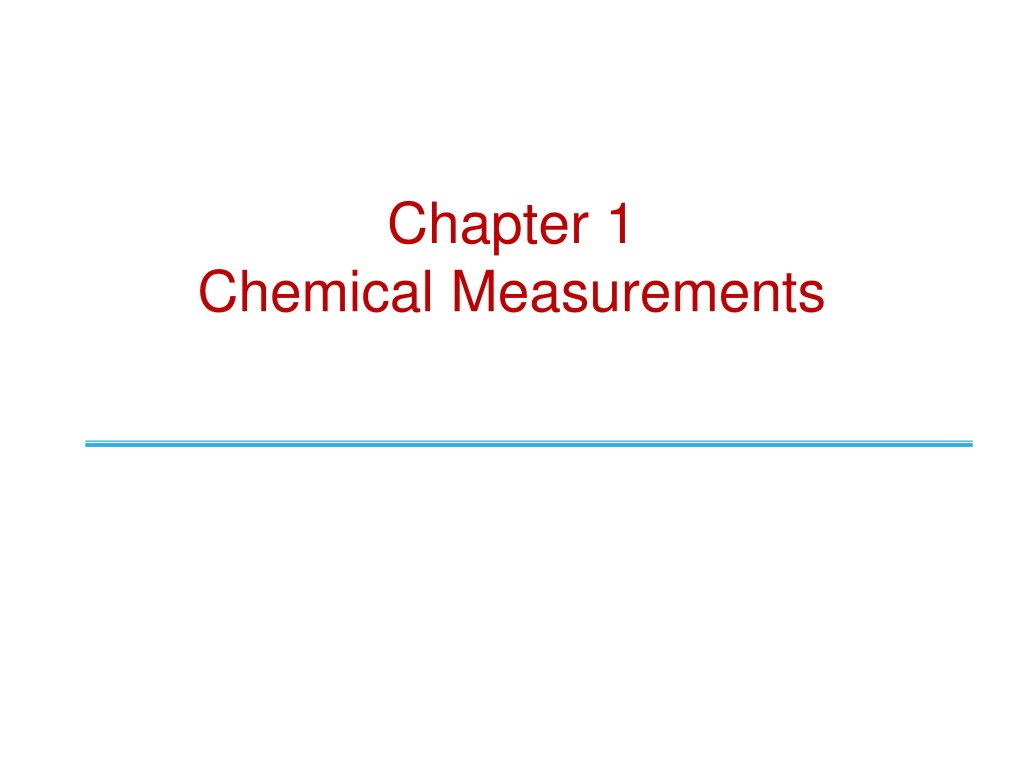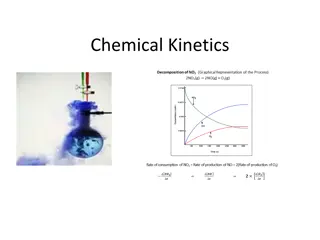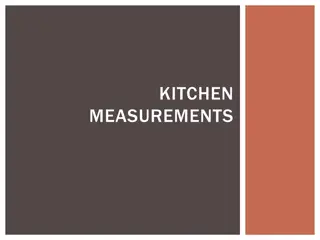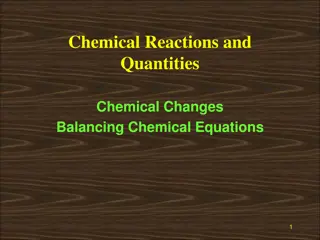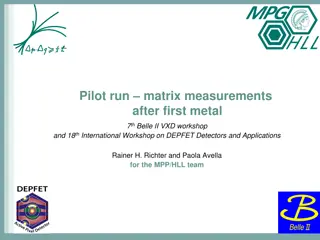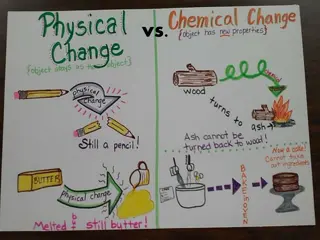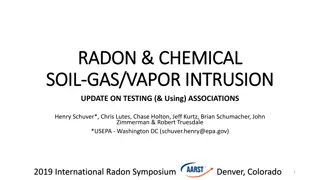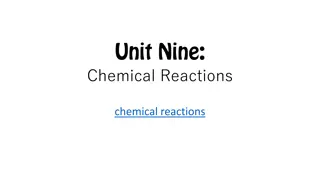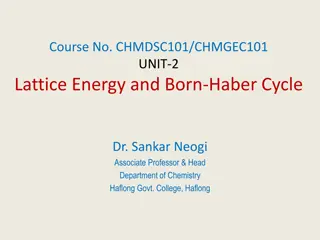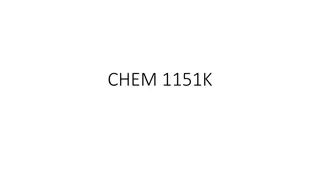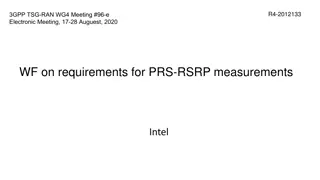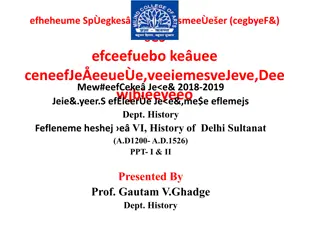Chemical Measurements Overview
In Chapter 1 - Chemical Measurements, you will delve into SI Units, derived SI units, prefixes, unit conversions, concentrations like molarity and molality, and percent compositions. Explore how to use prefixes for calculations, convert units, and understand different concentration measurements for solutions. Learn about specific energy calculations, parts per million, and percent compositions in various solutions.
Uploaded on Oct 05, 2024 | 0 Views
Download Presentation

Please find below an Image/Link to download the presentation.
The content on the website is provided AS IS for your information and personal use only. It may not be sold, licensed, or shared on other websites without obtaining consent from the author.If you encounter any issues during the download, it is possible that the publisher has removed the file from their server.
You are allowed to download the files provided on this website for personal or commercial use, subject to the condition that they are used lawfully. All files are the property of their respective owners.
The content on the website is provided AS IS for your information and personal use only. It may not be sold, licensed, or shared on other websites without obtaining consent from the author.
E N D
Presentation Transcript
Chapter 1 Chemical Measurements
Overview 1-1 SI Units 1-2 Chemical Concentrations 1-3 Preparing Solutions 1-4 Stoichiometry Calculations for Gravimetric Analysis
SI Units SI base units include the following: meter (m) kilogram (kg) second (s) ampere (A) kelvin (K) mole (mol)
Derived SI Units Other quantities can be derived in terms of base SI units. See Table 1-2. force (newton, N), Kg m / s2 pressure (pascal, Pa), N / m2 energy (joule, J), N m
Prefixes Table 1.3 Memorize these prefixes with their abbreviations and powers of ten.
Using Prefixes in Calculations In calculations, units should be carried along with the numbers. Prefixes such as kilo- and milli- are used to denote multiples of units. Prefixes can be used to simplify conversions between units. Example: Express 19.3 mPa in terms of atm 19.3 mPa can be written as 19.3 10-3 Pa 1.00 atm 3 - 7 10 . 1 = 19.3 Pa 90 10 atm 101325 Pa
Unit Conversions The calorie content of a candy bar is 230 calories per serving (1 bar). Calculate the specific energy (kJ/g) of the candy bar. (1 candy bar = 52.7 g, 1 calorie = 4.184 J)
Concentrations Molarity (moles of solute per liter of solution), M Molality (moles of solute per kilogram of solvent), m Formal concentration (formula units per liter), F Percent composition (w/w, v/v or w/v), % Parts per million, ppm Parts per billion, ppb
% Composition (w/w or v/v) 95% (w/w) ethanol contains 95 g of ethanol for every 100 g of solution.
ppm, Parts per Million Shortcut: ppm is also mg/L or g/mL if the density of the solution is 1.0 g/mL. An aqueous solution that is 1000 ppm in Cu contains 1000 mg Cu per liter of solution. It also contains 1000 g per mL of solution.
Chemical Concentratons The maximum contaminant level for arsenic is 0.010 ppm for drinking water per EPA regulation. The arsenic concentration for the drinking water of a municipality was measured to be 4.92 10 6 M arsenic. What is the arsenic concentration of the water sample in ppm? Does the water sample meet EPA guidelines? Assume the drinking water sample has a density of 1.0000 g/mL.
Making Solutions How many moles of CuCl2 5H2O are needed to make 500 mL of a solution that is 1,000.0 ppm in Cu? grams of CuCl2 5H2O? milliliters of 10,000 ppm CuCl2 5H2O solution? Figure 1-4
Making Solutions To calculate quantities of reagents needed to prepare solutions, use the relation (Mconc)(Vconc) = (Mdil)(Vdil) Equates moles of reagent removed from a stock solution to moles delivered into a new solution.
Preparing Solutions Calculate the mass of Na2CO3 needed to prepare a 15.00 mM solution with a volume of 500.0 mL. (Na2CO3 = 105.9888 g/mol)
Preparing Solutions What volume of 12.1 M HCl must be diluted to prepare a 0.2500 M HCl solution with a volume of 2.000 L?
Preparing Solutions What volume of a 50.0% by mass NaOH solution must be diluted to prepare a 0.3500 M NaOH solution with a volume of 500 mL? The density of 50% NaOH solution is 1.515 g/mL at 25 C. (NaOH = 40.00 g/mol)
Stoichiometry Use stoichiometry relationships to calculate required masses or volumes of reagents for chemical reactions. From the mass of product of a reaction, you should be able to compute how much reactant was consumed.
Stoichiometry The recommended daily allowance of calcium for men between the ages of 19 to 50 is 1000 mg Ca. Three multivitamin tablets are analyzed for calcium gravimetrically with the precipitation of calcium cation by oxalate anion. If the mass of dry calcium oxalate obtained is 2.0136 g, how many tablets must a man take in a given day to meet the recommended daily allowance? Ca2+ (aq) + C2O42 (aq) CaC2O4 (s)
Stoichiometry The sulfur content of an ore is determined gravimetrically by reacting the ore with concentrated nitric acid and potassium chlorate, converting all sulfur to sulfate. The excess nitrate and chlorate is removed by reaction with concentrated hydrochloric acid and the sulfate is precipitated using barium cation. Ba2+ (aq) + SO42- (aq) BaSO4 (s) Analysis of 10.1830 grams of a sulfur containing ore yielded 13.0221 grams of BaSO4. What is the percent by mass sulfur in the ore? (BaSO4 = 233.43 g/mol)
Limiting Reagent The limiting reagent in a chemical reaction is the one that is consumed first. Once the limiting reagent is gone, the reaction ceases. Example: For the reaction: A + 2B P 0.751 moles of A are mixed with 1.43 moles of B. What is the limiting reagent and how much excess reagent remains unreacted?
Limiting Reactant Aqueous lead precipitates when mixed with aqueous carbonate. Pb2+ (aq) + CO32 (aq) PbCO3 (s) If 5.000 g Pb(NO3)2 and 2.500 g Na2CO3 are mixed in water, which ion is the limiting reactant? What mass PbCO3 is precipitated? (PbCO3 = 267.21 g/mol, Pb(NO3)2 = 331.2 g/mol, Na2CO3 = 105.9888 g/mol)
